Tips and practical test questions and answers for getting Microsoft exam certification (70-761 exam, 70-762 exam, 70-764 exam, 70-765 exam, 70-767 exam)(First: Exam practice test, Second: leads4pass Microsoft expert.) You can get free Microsoft exam practice test questions here. Or choose: https://www.leads4pass.com/mcsa.html Study hard to pass the exam easily!
Table of Contents:
- Latest Microsoft 70-761 exam List
- Latest Microsoft 70-762 exam List
- Latest Microsoft 70-764 exam List
- Latest Microsoft 70-765 exam List
- Latest Microsoft 70-767 exam List
- leads4pass Year-round Discount Code
- What are the advantages of leads4pass?
Latest Microsoft MCSA Certifications Exam questions
Latest Microsoft 70-761 exam List
Exam 70-761: Querying Data with Transact-SQL – Microsoft: https://www.microsoft.com/en-us/learning/exam-70-761.aspx
Latest updates Microsoft 70-761 exam practice questions(1-5)
QUESTION 1
Note: This question is part of a series of questions that use the same or similar answer choices. An answer choice may
be correct for more than one question in the series. Each question is independent of the other questions in this series.
Information and details provided in a question apply only to that question.
You create a table by running the following Transact-SQL statement:

You are developing a report that displays customer information. The report must contain a grand total column.
You need to write a query that returns the data for the report.
Which Transact-SQL statement should you run?
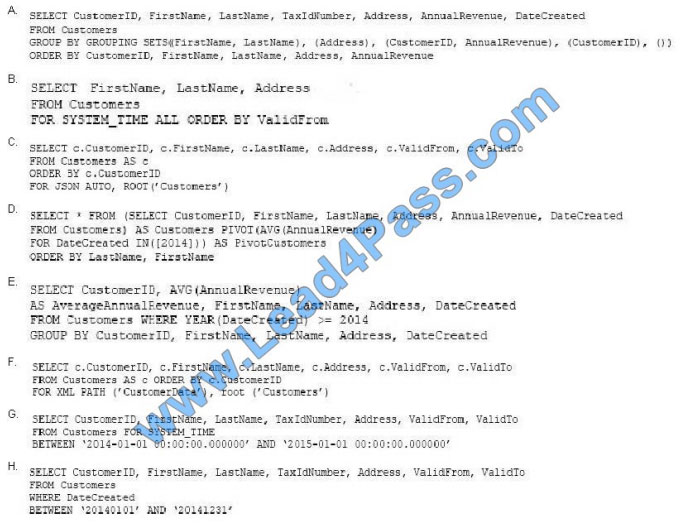
A. B. C. D. E. F. G. H.
Correct Answer: E
Calculate aggregate column through AVG function and GROUP BY clause.
QUESTION 2
Note: This question is part of a series of questions that use the same or similar answer choices. An answer choice may
be correct for more than one question in the series. Each question is independent of the other questions in this series.
Information and details provided in a question apply only to that question.
You have a database that contains several connected tables. The tables contain sales data for customers in the United
States only.
All the sales data is stored in a table named table1. You have a table named table2 that contains city names.
You need to create a query that lists only the cities that have no sales.
Which statement clause should you add to the query?
A. GROUP BY
B. MERGE
C. GROUP BY ROLLUP
D. LEFT JOIN
E. GROUP BY CUBE
F. CROSS JOIN
G. PIVOT
H. UNPIVOT
Correct Answer: D
Reference: https://docs.microsoft.com/en-us/sql/t-sql/queries/from-transact-sql?view=sql-server-2017
QUESTION 3
SIMULATION
You have a database that contains the following tables.
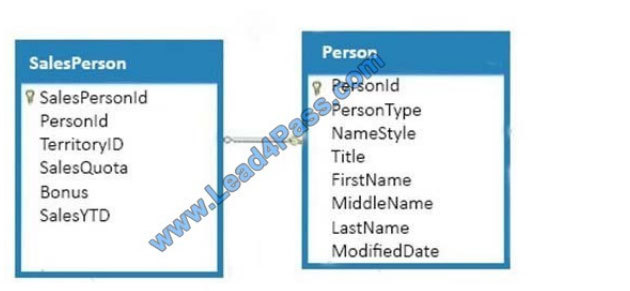
You need to create a query that lists the highest-performing salespersons based on the current year-to-date sales
period. The query must meet the following requirements:
Return the LastName and SalesYTD for the three salespersons with the highest year-to-date sales values.
Exclude salespersons that have no value for TerritoryID.
Construct the query using the following guidelines:
Use the first letter of a table name as the table alias.
Use two-part column names.
Do not surround object names with square brackets.
Do not use implicit joins.
Use only single quotes for literal text.
Use aliases only if required.
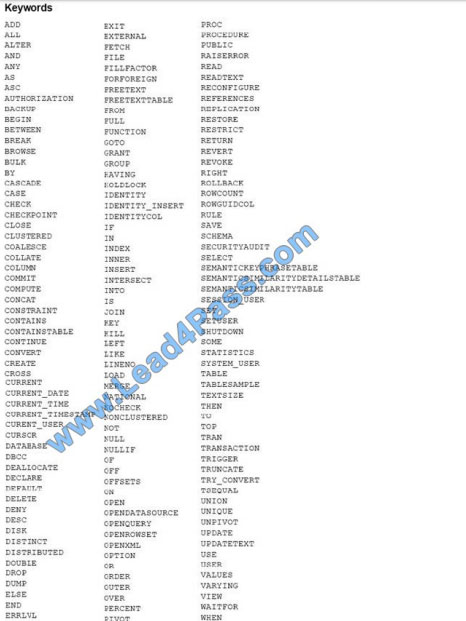
Part of the correct Transact-SQL has been provided in the answer area below. Enter the code in the answer area that
resolves the problem and meets the stated goals or requirements. You can add code within the code that has been
provided as well as below it.
1 SELECT top 3 lastname,salesYTD 2 FROM Person AS p INNER JOIN SalesPerson AS s 3 ON p.PersonID =
s.SalesPersonID 4 WHERE territoryid is null 5 order by salesytd dsec
Use the Check Syntax button to verify your work. Any syntax or spelling errors will be reported by line and character
position.
A. Check the answer in explanation.
Correct Answer: A
QUESTION 4
DRAG DROP
Note: This question is part of a series of questions that use the same scenario. For your convenience, the scenario is
repeated in each question. Each question presents a different goal and answer choices, but the text of the scenario is
exactly the same in each question in this series.
Start of repeated scenario
You have a database that contains the tables shown in the exhibit. (Click the Exhibit button.)
You review the Employee table and make the following observations:
Every record has a value in the ManagerID except for the Chief Executive Officer (CEO).
The FirstName and MiddleName columns contain null values for some records.
The valid values for the Title column are Sales Representative manager, and CEO.
You review the SalesSummary table and make the following observations:
The ProductCode column contains two parts: The first five digits represent a product code, and the last seven digits
represent the unit price. The unit price uses the following pattern: ####.##.
You observe that for many records, the unit price portion of the ProductCode column contains values.
The RegionCode column contains NULL for some records.
Sales data is only recorded for sales representatives.
You are developing a series of reports and procedures to support the business. Details for each report or procedure
follow.
Sales Summary report: This report aggregates data by year and quarter. The report must resemble the following table.

Sales Manager report: This report lists each sales manager and the total sales amount for all employees that report to
the sales manager.
Sales by Region report: This report lists the total sales amount by employee and by region. The report must include the
following columns: EmployeeCode, MiddleName, LastName, RegionCode, and SalesAmount. If MiddleName is NULL,
FirstName must be displayed. If both FirstName and MiddleName have null values, the world Unknown must be
displayed/ If RegionCode is NULL, the word Unknown must be displayed.
Report1: This report joins data from SalesSummary with the Employee table and other tables. You plan to create an
object to support Report1. The object has the following requirements:
be joinable with the SELECT statement that supplies data for the report
can be used multiple times with the SELECT statement for the report
be usable only with the SELECT statement for the report
not be saved as a permanent object
Report2: This report joins data from SalesSummary with the Employee table and other tables. You plan to create an
object to support Report1. The object has the following requirements:
be joinable with the SELECT statement that supplies data for the report
can be used multiple times for this report and other reports
accept parameters
be saved as a permanent object
Sales Hierarchy report: This report aggregates rows, creates subtotal rows, and super-aggregates rows over the
SalesAmount column in a single result-set. The report uses SaleYear, SaleQuarter, and SaleMonth as a hierarchy. The
result set must not contain a grand total or cross-tabulation aggregate rows.
Current Price Stored Procedure: This stored procedure must return the unit price for a product when a product code is
supplied. The unit price must include a dollar sign at the beginning. In addition, the unit price must contain a comma
every three digits to the left of the decimal point, and must display two digits to the left of the decimal point. The stored
procedure must not throw errors, even if the product code contains invalid data.
End of Repeated Scenario
You need to create the query for the Sales Managers report.
Which four Transact-SQL segments should you use to develop the solution? To answer, move the appropriate TransactSQL segments from the list of Transact-SQL segments to the answer area and arrange them in the correct order.
Select and Place:
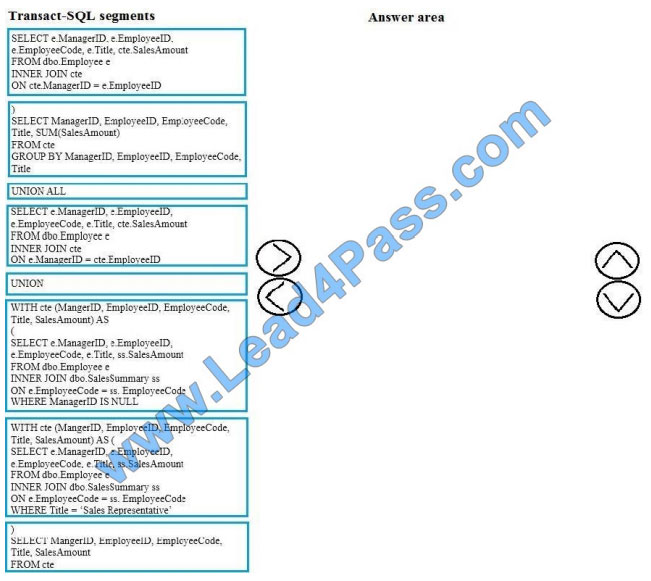
Correct Answer:
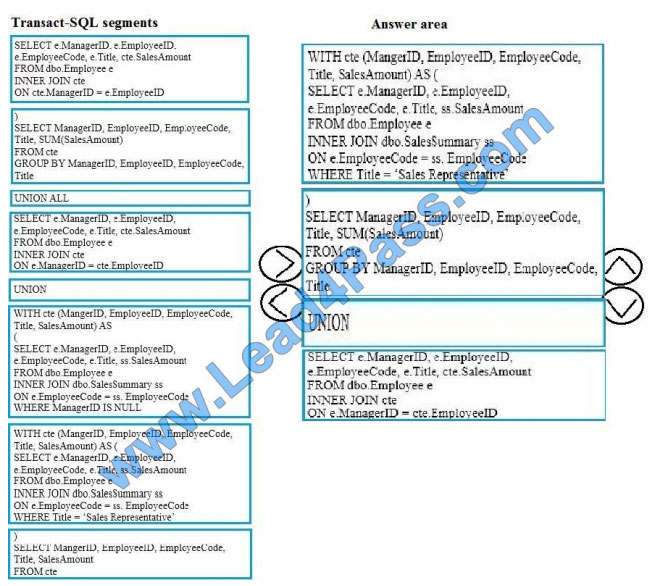
From scenario: Sales Manager report: This report lists each sales manager and the total sales amount for all employees
that report to the sales manager. Box 1:..WHERE Title=\\’Sales representative\\’
The valid values for the Title column are Sales Representative manager, and CEO.
First we define the CTE expression.
Note: A common table expression (CTE) can be thought of as a temporary result set that is defined within the execution
scope of a single SELECT, INSERT, UPDATE, DELETE, or CREATE VIEW statement. A CTE is similar to a derived
table in that it is not stored as an object and lasts only for the duration of the query. Unlike a derived table, a CTE can be
self-referencing and can be referenced multiple times in the same query.
Box 2:
Use the CTE expression one time.
Box 3: UNION
Box 4:
Use the CTE expression a second time.
References: https://technet.microsoft.com/en-us/library/ms190766(v=sql.105).aspx
QUESTION 5
Note: This question is part of a series of questions that use the same or similar answer choices. An answer choice may
be correct for more than one question in the series. Each question is independent of the other questions in this series.
Information and details provided in a question apply only to that question.
You have a table named Person that contains information about employees. Users are requesting a way to access
specific columns from the Person table without specifying the Person table in the query statement. The columns that
users can access will be determined when the query is running against the data. There are some records that are
restricted, and a trigger will evaluate whether the request is attempting to access a restricted record.
You need to ensure that users can access the needed columns while minimizing storage on the database server.
What should you implement?
A. the COALESCE function
B. a view
C. a table-valued function
D. the TRY_PARSE function
E. a stored procedure
F. the ISNULL function
G. a scalar function
H. the TRY_CONVERT function
Correct Answer: B
References: https://docs.microsoft.com/en-us/sql/t-sql/statements/create-view-transact-sql?view=sql-server-2017
[PDF q1 – q13] Free Microsoft 70-761 pdf dumps download from Google Drive: https://drive.google.com/open?id=1gBmxHX3avy8NXVFPuo5DXdHbCFY0w1kK
Full Microsoft 70-761 exam practice questions: https://www.leads4pass.com/70-761.html (Total Questions: 221 Q&A)
Latest Microsoft 70-762 exam List
Exam 70-762: Developing SQL Databases – Microsoft:https://www.microsoft.com/en-us/learning/exam-70-762.aspx
Latest updates Microsoft 70-762 exam practice questions (1-4)
QUESTION 1
Note: This question is part of a series of questions that use the same or similar answer choices. An answer choice may
be correct for more than one question in the series. Each question is independent of the other questions in this series.
Information and details provided in a question apply only to that question.
You have a database named DB1. There is no memory-optimized filegroup in the database.
You have a table and a stored procedure that were created by running the following Transact-SQL statements:
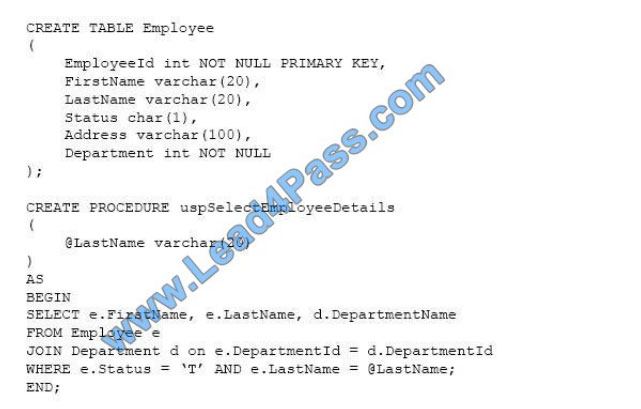
The Employee table is persisted on disk. You add 2,000 records to the Employee table.
You need to create an index that meets the following requirements:
Optimizes the performance of the stored procedure.
Covers all the columns required from the Employee table.
Uses FirstName and LastName as included columns.
Minimizes index storage size and index key size.
What should you do?
A. Create a clustered index on the table.
B. Create a nonclustered index on the table.
C. Create a nonclustered filtered index on the table.
D. Create a clustered columnstore index on the table.
E. Create a nonclustered columnstore index on the table.
F. Create a hash index on the table.
Correct Answer: B
References: https://technet.microsoft.com/en-us/library/jj835095(v=sql.110).aspx
QUESTION 2
Note: This question is part of a series of questions that present the same scenario. Each question in the series contains
a unique solution. Determine whether the solution meets the stated goals. You have a table that has a clustered index
and a nonclustered index. The indexes use different columns from the table. You have a query named Query1 that uses
the nonclustered index.
Users report that Query1 takes a long time to report results. You run Query1 and review the following statistics for an
index seek operation: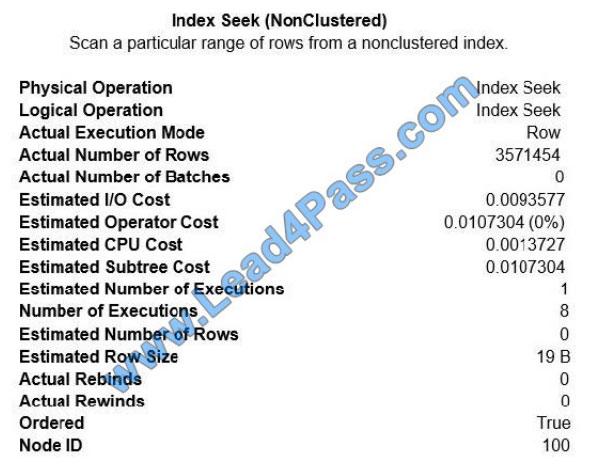
You need to resolve the performance issue.
Solution: You update statistics for the nonclustered index.
Does the solution meet the goal?
A. Yes
B. No
Correct Answer: A
We see Actual Number of Row is 3571454, while Estimated Number of Rows is 0. This indicates that the statistics are
old, and need to be updated.
QUESTION 3
Note: This question is part of a series of questions that use the same or similar answer choices. As answer choice may
be correct for more than one question in the series. Each question is independent of the other questions
in this series.
Information and details provided in a question apply only to that question.
You have a Microsoft SQL Server database named DB1 that contains the following tables:
Users frequently run the following query:

Users report that the query takes a long time to return results.
You need to minimize the amount of time requires for the query to return data.
What should you do?
A. Create clustered indexes on TBL1 and TBL2.
B. Create a clustered index on TBL1.Create a nonclustered index on TBL2 and add the most frequently queried column
as included columns.
C. Create a nonclustered index on TBL2 only.
D. Create UNIQUE constraints on both TBL1 and TBL2. Create a partitioned view that combines columns from TBL1
and TBL2.
E. Drop existing indexes on TBL1 and then create a clustered columnstore index. Create a nonclustered columnstore
index on TBL1.Create a nonclustered index on TBL2.
F. Drop existing indexes on TBL1 and then create a clustered columnstore index. Create a nonclustered columnstore
index on TBL1.Make no changes to TBL2.
G. Create CHECK constraints on both TBL1 and TBL2. Create a partitioned view that combines columns from TBL1 and
TBL2.
H. Create an indexed view that combines columns from TBL1 and TBL2.
Correct Answer: H
QUESTION 4
Note: This question is part of a series of questions that use the same scenario. For your convenience, the scenario is
repeated in each question. Each question presents a different goal and answer choices, but the text of the scenario is
exactly the same in each question in this series.
You have a database that contains the following tables: BlogCategory, BlogEntry, ProductReview, Product, and
SalesPerson. The tables were created using the following Transact SQL statements: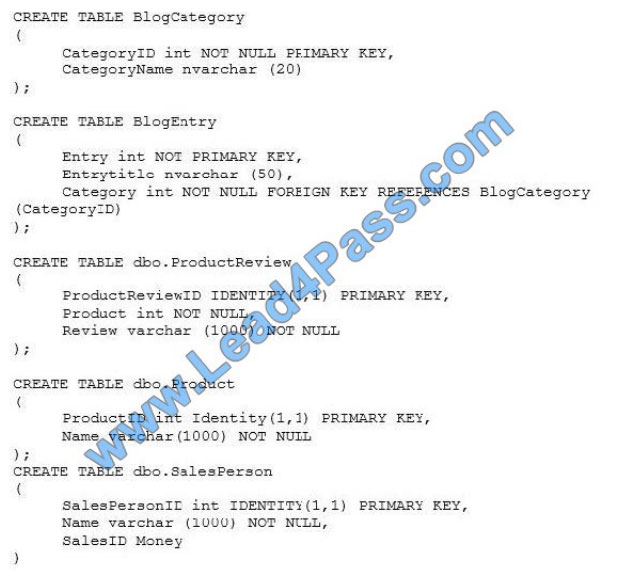
You must modify the ProductReview Table to meet the following requirements:
* The table must reference the ProductID column in the Product table.
* Existing records in the ProductReview table must not be validated with the Product table.
* Deleting records in the Product table must not be allowed if records are referenced by the ProductReview table.
* Changes to records in the Product table must propagate to the ProductReview table.
You also have the following database tables: Order, ProductTypes, and SalesHistory, The transact-SQL statements for
these tables are not available.
You must modify the Orders table to meet the following requirements:
* Create new rows in the table without granting INSERT permissions to the table.
* Notify the sales person who places an order whether or not the order was completed.
You must add the following constraints to the SalesHistory table:
* a constraint on the SaleID column that allows the field to be used as a record identifier
* a constant that uses the ProductID column to reference the Product column of the ProductTypes table
* a constraint on the CategoryID column that allows one row with a null value in the column
* a constraint that limits the SalePrice column to values greater than four
Finance department users must be able to retrieve data from the SalesHistory table for sales persons where the value
of the SalesYTD column is above a certain threshold.
You plan to create a memory-optimized table named SalesOrder. The table must meet the following requirements:
* The table must hold 10 million unique sales orders.
* The table must use checkpoints to minimize I/O operations and must not use transaction logging.
* Data loss is acceptable.
Performance for queries against the SalesOrder table that use Where clauses with exact equality operations must be
optimized.
How should you complete the Transact-SQL statements? To answer, select the appropriate Transact-SQL segments in
the answer area.
Hot Area:
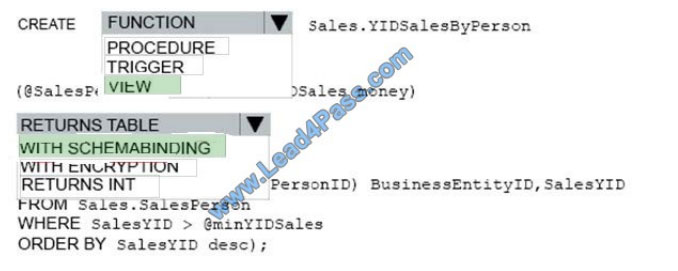
Correct Answer:
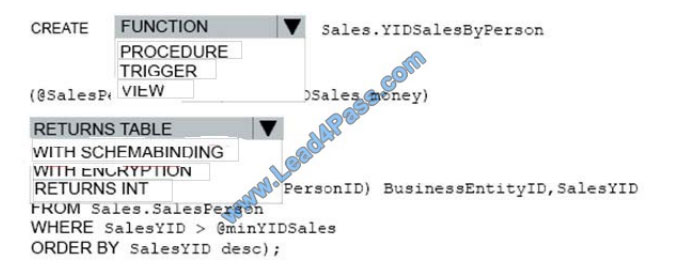
[PDF q1 – q13] Free Microsoft 70-762 pdf dumps download from Google Drive: https://drive.google.com/open?id=1sdJdQFp4c17m4x4dlx6d1aHK9GQX7CjE
Full Microsoft 70-762 exam practice questions: https://www.leads4pass.com/70-762.html (Total Questions: 177 Q&A)
Latest Microsoft 70-764 exam List
Exam 70-764: Administering a SQL Database Infrastructure:https://www.microsoft.com/en-us/learning/exam-70-764.aspx
Latest updates Microsoft 70-764 exam practice questions (1-4)
QUESTION 1
You need to provide a group of users from the IT and Manufacturing departments the minimum administrative rights to
view database information and server state for the Manufacturing database on MainDB1. What should you do?
A. You should configure a Database Role.
B. You should configure a Server Role.
C. You should configure a Shared SQL Server Login.
D. You should configure a Local Security Group.
Correct Answer: B
QUESTION 2
You administer a SQL Server instance. A database named DB1 is corrupted.
Backups of DB1 are available on a disk backup device located at Z:\Backups\Backup.bak.
The backup device has the following backups sets:
a full database backup that is the first backup set on the device (FILE = 1)
a differential database backup that is the second backup set on the device (FILE = 2)
a transaction log backup that is the third backup set on the device (FILE = 3)
You restore the full database backup and the differential database backup without rolling back the uncommitted
transactions.
You need to restore the transaction log backup and ensure the database is ready for use after restoring the transaction
log.
How should you complete the Transact-SQL statement? To answer, drag the appropriate Transact-SQL segments to
the correct locations. Each Transact-SQL segment may be used once, more than once, or not at all. You may need to
drag
the split bar between panes or scroll to view content.
Select and Place: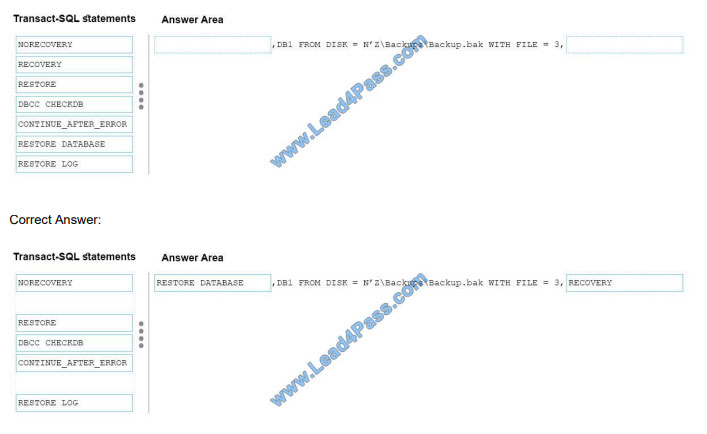
The RESTORE restores backups taken using the BACKUP command. You can do restore a transaction log onto a
database (a transaction log restore).
NORECOVERY specifies that roll back not occur. This allows roll forward to continue with the next statement in the
sequence. In this case, the restore sequence can restore other backups and roll them forward.
RECOVERY (the default) indicates that roll back should be performed after roll forward is completed for the current
backup.
Recovering the database requires that the entire set of data being restored (the roll forward set) is consistent with the
database. If the roll forward set has not been rolled forward far enough to be consistent with the database and
RECOVERY
is specified, the Database Engine issues an error.
References: https://docs.microsoft.com/en-us/sql/t-sql/statements/restore-statementstransact-sql
QUESTION 3
You are implementing a SQL Server 2016 five-node failover cluster.
You need to choose a quorum configuration.
Which configuration should you use?
A. Distributed File System (DFS)
B. Node Majority
C. Cluster Shared Volume (CSV)
D. Node and Disk Majority
Correct Answer: D
Node and Disk Majority (recommended for clusters with an even number of nodes) Incorrect Answers:
B: Node Majority (recommended for clusters with an odd number of nodes)
References: https://docs.microsoft.com/en-us/previous-versions/windows/it-pro/windowsserver-2008-R2-and-2008/cc731739(v=ws.11)
QUESTION 4
Note: This question is part of a series of questions that use the same or similar answer choices. An answer choice may
be correct for more than one question in the series. Each question is independent of the other questions in this series.
Information and details provided in a question apply only to that question.
A company has a Microsoft SQL Server environment in Microsoft Azure. The databases are stored directly in Azure blob
storage.
You need to ensure that you can restore a database to a specific point in time between backups while minimizing the
number of Azure storage containers required.
Which option should you use?
A. backup compression
B. backup encryption
C. file snapshot backup
D. mirrored backup media sets
E. SQL Server backup to URL
F. SQL Server Managed Backup to Azure
G. tail-log backup
H. back up and truncate the transaction log
Correct Answer: F
SQL Server Managed Backup to Microsoft Azure supports point in time restore for the retention time period specified.
References: https://docs.microsoft.com/en-us/sql/relational-databases/backup-restore/sql-server-managed-backup-tomicrosoft-azure?view=sql-server-2017
[PDF q1 – q13] Free Microsoft 70-764 pdf dumps download from Google Drive: https://drive.google.com/open?id=1F_S503N-ynLs2f0YVIGYWgHDzKQuW-gT
Full Microsoft 70-764 exam practice questions: https://www.leads4pass.com/70-764.html (Total Questions: 445 Q&A)
Latest Microsoft 70-765 exam List
Exam 70-765: Provisioning SQL Databases – Microsoft:https://www.microsoft.com/en-us/learning/exam-70-765.aspx
Latest updates Microsoft 70-765 exam practice questions (1-5)
QUESTION 1
You have an on-premises database.
You plan to migrate the database to Microsoft SQL Server on a Microsoft Azure virtual machine.
You move the database files to Azure.
You need to attach the database files to the SQL Server instance on the virtual machine.
The solution must ensure that you can run file snapshot backups.
How should you complete the statement? To answer, select the appropriate options in the answer area.
NOTE: Each correct selection is worth one point.
Hot Area:
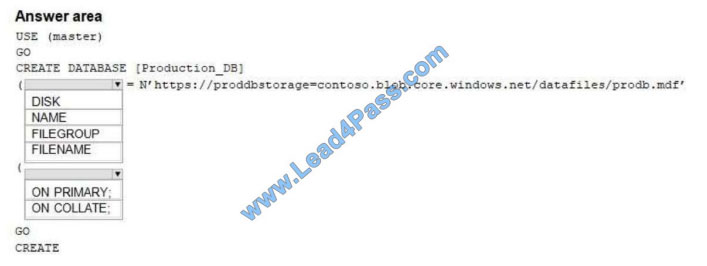
Correct Answer:
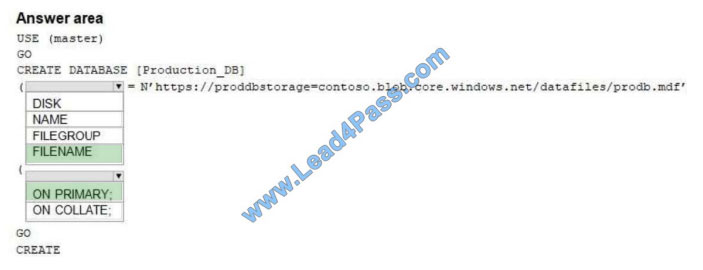
References: https://docs.microsoft.com/en-us/sql/t-sql/statements/create-database-sqlserver-transact-sql
QUESTION 2
You administer a Microsoft SQL Server 2014 database that contains a table named AccountTransaction.
You discover that query performance on the table is poor due to fragmentation on the
IDX_AccountTransaction_AccountCode non-clustered index. You need to defragment the index. You also need to
ensure that user queries are able to use
the index during the defragmenting process.
Which Transact-SQL batch should you use?
A. ALTER INDEX IDX_AccountTransaction_AccountCode ONAccountTransaction.AccountCode REORGANIZE
B. ALTER INDEX ALL ON AccountTransaction REBUILD
C. ALTER INDEX IDX_AccountTransaction_AccountCode ONAccountTransaction.AccountCode REBUILD
D. CREATE INDEX IDXAccountTransactionAccountCode ONAccountTransaction.AccountCode WITH DROP
EXISTING
Correct Answer: A
Reorganize: This option is more lightweight compared to rebuild. It runs through the leaf level of the index, and as it
goes it fixes physical ordering of pages and also compacts pages to apply any previously set fillfactor settings. This
operation is always online, and if you cancel it then it\\’s able to just stop where it is (it doesn\\’t have a giant operation to
rollback).
References: https://www.brentozar.com/archive/2013/09/index-maintenance-sql-server-rebuild-reorganize/
QUESTION 3
You administer a Microsoft SQL Server database named Sales. The database is 3 terabytes in size. The Sales
database is configured as shown in the following table.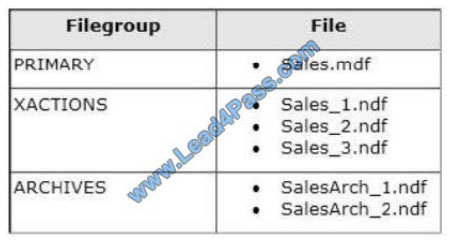
You discover that all files except Sales_2.ndf are corrupt.
You need to recover the corrupted data in the minimum amount of time. What should you do?
A. Perform a file restore.
B. Perform a transaction log restore.
C. Perform a restore from a full backup.
D. Perform a filegroup restore.
Correct Answer: A
In a file restore, the goal is to restore one or more damaged files without restoring the whole database.
References: https://docs.microsoft.com/en-us/sql/relational-databases/backup-restore/file-restores-simple-recoverymodel
QUESTION 4
A company has an on-premises Microsoft SQL Server 2017 infrastructure. The storage area network (SAN) that
supports the SQL infrastructure has reached maximum capacity.
You need to recommend a solution to reduce on-premises storage use without changing the application.
What should you do?
A. Configure an Express Route connection to Microsoft Azure.
B. Configure a Microsoft Azure Key Vault.
C. Configure geo-replication on the SAN.
D. Configure SQL Server Stretch Database in Microsoft Azure.
Correct Answer: D
Stretch warm and cold transactional data dynamically from SQL Server to Microsoft Azure with SQL Server Stretch
Database. Unlike typical cold data storage, your data is always online and available to query. Benefit from the low cost
of Azure rather than scaling expensive, on-premises storage.
References: https://docs.microsoft.com/en-us/sql/sql-server/stretch-database/stretch-database?view=sql-server-2017
QUESTION 5
You have just completed a new Microsoft SQL Server installation.
You need to configure a new SQL Server Agent alert to send an email to the DBA team for severity 20 errors.
Which three actions should you perform? Each correct answer presents part of the solution. (Choose three.)
A. Set up SQL Mail.
B. Define an operator.
C. Configure a credential object.
D. Define the alert settings.
E. Configure a proxy.
F. Set up an External Events collector.
G. Set up Database Mail.
Correct Answer: BDG
Reference: https://docs.microsoft.com/en-us/sql/relational-databases/database-mail/configure-sql-server-agent-mail-touse-database-mail?view=sql-server-2017
[PDF q1 – q13] Free Microsoft 70-765 pdf dumps download from Google Drive: https://drive.google.com/open?id=1qgtnHxfCyCuDMhRti9XEceZw5cNWhvXd
Full Microsoft 70-765 exam practice questions: https://www.leads4pass.com/70-765.html (Total Questions: 272 Q&A)
Latest Microsoft 70-767 exam List
Exam 70-767: Implementing a Data Warehouse using SQL:https://www.microsoft.com/en-us/learning/exam-70-767.aspx
Latest updates Microsoft 70-767 exam practice questions (1-4)
QUESTION 1
Note: This question is part of a series of questions that use the same or similar answer choices. An answer choice may
be correct for more than one question in the series. Each question is independent of the other questions in this series.
Information and details provided in a question apply only to that question.
You are a database administrator for an e-commerce company that runs an online store. The company has the
databases described in the following table.
Each week, you import a product catalog from a partner company to a staging table in DB2.
You need to create a stored procedure that will update the staging table by inserting new products and deleting
discontinued products.
What should you use?
A. Lookup transformation
B. Merge transformation
C. Merge Join transformation
D. MERGE statement
E. Union All transformation
F. Balanced Data Distributor transformation
G. Sequential container
H. Foreach Loop container
Correct Answer: G
QUESTION 2
You manage the user accounts in master data Services (MDS).
You need to assign a user access to the MDS data and functions.
Which two components must you assign? Each correct answer presents part of the solution.
NOTE: Each correct selection is worth one point.
A. file share permissions
B. model object permissions
C. functional area permissions
D. SQL Database permissions
Correct Answer: BC
B: In Master Data Services, assign permissions to model objects when you need to give a user or group access to data
in the Explorer functional area of Master Data Manager, or when you need to make a user or group an administrator.
C: Assign functional area permission to grant users or groups access to the functional areas of Master Data Manager.
To assign functional area permissions
1.
In Master Data Manager, click User and Group Permissions.
2.
On the Users or Groups page, select the row for the user or group that you want to edit.
3.
Click Edit selected user.
4.
Click the Functions tab.
5.
Click Edit.
6.
Click a functional area and click the Add arrow.
7.
When you are done, click Save.
References: https://docs.microsoft.com/en-us/sql/master-data-services/assign-model-object-permissions-master-dataservices https://docs.microsoft.com/en-us/sql/master-data-services/assign-functional-area-permissions-master-dataservices
QUESTION 3
Note: This question is part of a series of questions that present the same scenario. Each question in the series contains
a unique solution that might meet the stated goals. Some question sets might have more than one correct solution,
while others might not have a correct solution.
After you answer a question in this section, you will NOT be able to return to it. As a result, these questions will not
appear in the review screen.
You have a Microsoft SQL server that has Data Quality Services (DQS) installed. You need to review the completeness
and the uniqueness of the data stored in the matching policy. Solution: You modify the weight of the domain in the
matching rule.
Does this meet the goal?
A. Yes
B. No
Correct Answer: A
Use a matching rule, and use completeness and uniqueness data to determine what weight to give a field in the
matching process.
If there is a high level of uniqueness in a field, using the field in a matching policy can decrease the matching results, so
you may want to set the weight for that field to a relatively small value. If you have a low level of uniqueness for a
column,
but low completeness, you may not want to include a domain for that column.
References: https://docs.microsoft.com/en-us/sql/data-quality-services/create-a-matching-policy? view=sql-server-2017
QUESTION 4
You develop a SQL Server Integration Services (SSIS) package that imports SQL Azure data into a data warehouse
every night.
The SQL Azure data contains many misspellings and variations of abbreviations. To import the data, a developer used
the Fuzzy Lookup transformation to choose the closest- matching string from a reference table of allowed values. The
number of rows in the reference table is very large.
If no acceptable match is found, the Fuzzy Lookup transformation passes a null value.
The current setting for the Fuzzy Lookup similarity threshold is 0.50.
Many values are incorrectly matched.
You need to ensure that more accurate matches are made by the Fuzzy Lookup transformation without degrading
performance.
What should you do?
A. Change the Exhaustive property to True.
B. Change the similarity threshold to 0.55.
C. Change the similarity threshold to 0.40.
D. Increase the maximum number of matches per lookup.
Correct Answer: B
http://msdn.microsoft.com/en-us/library/ms137786.aspx
[PDF q1 – q13] Free Microsoft 70-767 pdf dumps download from Google Drive: https://drive.google.com/open?id=1CN6XG3cr7L9HDpk64aPRfHbIJrZsh3Yg
Full Microsoft 70-767 exam practice questions: https://www.leads4pass.com/70-767.html (Total Questions: 402 Q&A)
leads4pass Year-round Discount Code

What are the advantages of leads4pass?
leads4pass employs the most authoritative exam specialists from Cisco, Microsoft, EMC, CompTIA, etc. We update exam data throughout the year. Highest pass rate! We have a large user base. We are an industry leader!
Choose leads4pass to pass the exam with ease!

Summarize:
It’s not easy to pass the Microsoft exam, but with accurate learning materials and proper practice, you can crack the exam with excellent results. https://www.leads4pass.com/mcsa.html provides you with the most relevant learning materials that you can use to help you prepare.